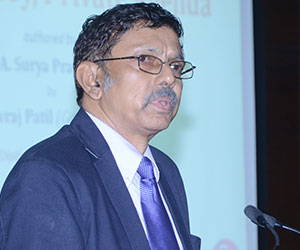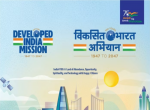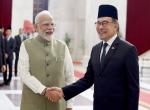The two main national parties – the Congress and the Bharatiya Janata Party (BJP) - are going to take a long time to digest the bitter medicine that has been administered to them by the electorate in the recent assembly elections held in five states.
Apart from the fact that these election results have once again shown the declining popularity of national parties, they have also shown that these parties are no big attraction for the youth and women, especially in Uttar Pradesh.
The Election Commission classifies the Congress, BJP, the two prominent communist parties, th Bahujan Samaj Party (BSP) and the Nationalist Congress Party as national parties. These are parties which cross a minimum threshold of votes in at least four states. In the Lok Sabha election held in 2009, national parties secured 63.58 per cent of the vote, with a good chunk of the remaining 36 per cent going to state parties. In the assembly elections held in 2007, the national parties had a vote share of 56.50 per cent in Uttar Pradesh. In 2012, their share of the votes is down by about 3 per cent. This still looks like a decent figure because the BSP is classified as a national party. If not, the share of national parties would be just 28 per cent. Similarly, there is a marginal drop of about 2 per cent in the vote share of national parties in Punjab as compared to 2007.
It was clear during the run up to the election in Uttar Pradesh that the Congress and the BJP were fighting for the third and fourth positions. The two parties have lived up to the general assessment of their electoral strengths. But what should be disquieting for both the parties is that out of the 403 assembly constituencies in this state, the contest was mainly between these two parties only in 11 seats namely Mathura, Bilaspur, Govindnagar,Tamkuhi Raj, Suar, Varanasi Cantt, Varanasi South, Kidwai Nagar, Lucknow Cantt, Pharenda and Saharanpur Nagar. In most of the assembly segments, the fight was mainly between the Samajwadi Party and the BSP and this left the two main national parties in dire straits. A high percentage of candidates (around 60 per cent) belonging to these two parties have forfeited their deposits and several of them have suffered humiliating defeats. For example, in Bah constituency, out of the 1.83 lakh votes polled, the Congress secured 2411 votes and the BJP, 2131. This means each party got just over 1 per cent of the total votes polled! There are many such examples. In Aliganj, the BJP has polled less than 1 per cent of the 1.96 lakh votes polled. The Congress has done marginally better with 4 per cent of the votes. Again, in Akbarpur, the Congress managed just 4 per cent and the BJP less than 2 per cent of the 1.72 lakh votes polled. There are dozens of such examples, which show how irrelevant the two parties had become in this election. The BJP also lost Ayodhya, a seat held by the party continuously for 20 years.
The disappointment is certain to be much more when these parties take into account the following factors: This election saw a huge jump in first time voters; a higher percentage of women voted in these elections; and although there are more urban seats now than before, the Samajwadi Party stormed into the urban citadels of these two parties.
In 2012, 13.70 million new voters were registered in Uttar Pradesh, as compared to 2007. Secondly, since the voting percentage shot up this time, 23.90 million more votes were cast in this election compared to 2007. In Punjab and Uttarakhand also, the number of voters went up by 11 lakhs and 3.80 lakhs respectively. But the most interesting and intriguing bit of statistic which should interest political pundits is that in all the five states which went to the polls – Uttar Pradesh, Uttarakhand, Punjab, Goa, and Manipur - the percentage of women who voted this time was higher than that of men by 2 to 3 per cent. The difference was the highest in Goa. In that state while 79.67 per cent of male voters exercised their franchise, the turnout of women voters was 85.97. This means that both first time voters and women found the Congress and the BJP not worthy of support in Uttar Pradesh. The BJP can feel good that the new voters and women have given it and its ally the thumbs up in Goa and Punjab. The Congress can similarly see Manipur, which witnessed a similar trend, as a consolation prize. But the truth is that none of this can obliterate the disturbing message from Uttar Pradesh for these two parties.
Following the delimitation of assembly and Lok Sabha constituencies in 2008, much of the imbalance in the spread of constituencies and total electors was corrected because the Delimitation Commission decided to redraw the boundaries based on population. This also meant a jump in urban constituencies in all states. After this Commission completed its task, the BJP was happy because there were more urban constituencies now than before. The Congress too was pleased because it felt the Rahul spell would work in the urban areas and bring in more seats. But the recent election in Uttar Pradesh has changed all that. The Samajwadi Party has made a confident entry into urban pockets. For example, in Lucknow, it has edged out these parties in three of the five seats. It has also made inroads into many other urban constituencies.
Yet another phenomenon that is certain to disturb the electoral base of the two main national parties is the emergence of the Peace Party of India (PPI). This party, launched by Muslims, made its debut only in 2009 and is now slowly but surely creeping up the electoral ladder. In this election it has bagged four Vidhan Sabha seats and secured 2.35 per cent of the votes. But, the vote share could be misleading because of the impact of its presence in 10-15 per cent of the constituencies. The data put out by the party in its website is interesting. It won 4 seats, stood second in three, third in 8 and fourth in 25 seats. In other words, the Peace Party has influenced the outcome in this election in at least 40 seats. The website says the party over 50,000 votes in three constituencies. It secured 20,000-50,000 votes in 15 seats and 8000-25,000 votes in 52 seats. This is how the BSP started out in the late 1980s and if this trend continues, the Peace Party will make elections in Uttar Pradesh a five-cornered affair some years from now. The party’s website also made the following observation which could be of value to political analysts – “ Besides winning four seats and securing second position at three places PPI has influenced results of at least 61 other constituencies where it secured more votes than the winning margin”. It also claimed that it had “broken the myth” that voting PPI would benefit the BJP, “because the BJP won only 8 seats out of the 61 constituencies mentioned above”.
How the two national parties have grievously erred in their politics in the Hindi heartland is best explained by the electoral performance of these two parties vis-à-vis the BSP and SP over the last two decades. In the Uttar Pradesh Vidhan Sabha election held in 1993, the BSP secured 11.50 and the SP 18.60 per cent of the vote, which meant that together these two parties obtained 30.10 per cent of the popular vote. As against this, the BJP secured 33.10 and the Congress 14.40 per cent votes. In other words, the two national parties commanded 47.50 per cent of the vote in that state. In 2012 one sees a neat reversal of this situation. The BSP (25.91) and the SP (29.15) together garnered 55 per cent of the vote, whereas the BJP ( 15.00 ) and Congress ( 11.63) managed just 27 per cent, which is much less than the share of the BSP and SP in 1993. It will be an uphill task for these two parties to regain their pre-1993 influence and to dislodge the SP and BSP from their pre-eminent perch.
Can the Nehru-Gandhis Bounce Back?
Apart from the poor performance of the Congress Party, the 2012 results also point to the declining influence of the party’s first family. In particular, the outcome in the Amethi-Rae Bareli-Sultanpur belt in Uttar Pradesh should be a matter of concern for the Nehru-Gandhis. The results show that the family’s vote bank has suffered considerable depletion in this belt, which was considered its bastion for many decades. Yet, given the distinct electoral advantage that the family has over others, can we presume that its charisma has evaporated altogether? A detailed analysis of the results and their implications may be in order.
When the assembly results came in on March 6, most analysts were shocked to see that the Congress Party won just 2 of the 15 assembly segments - Amethi (SP), Jagdishpur (Cong), Gauriganj (SP), Tiloi (Cong), Salon (SP), Rae Bareli (Peace Party), Sareni (SP), Bachhrawan (SP), Harchandpur (SP), Unchahar (SP), Sultanpur (SP), Sadar (SP), Lambhua (SP), Kadipur (SP), Isauli (SP) - falling within the Lok Sabha constituencies of Amethi, Rae Bareli and Sultanpur.
As against 8.74 lakh votes polled in the five assembly segments in Amethi represented by Rahul Gandhi, Congress candidates bagged 2.59 lakh votes constituting just under 30 per cent – hardly anything to crow about. However, the little hope that one sees in Amethi, is well and truly extinguished when one steps into Rae Bareli represented by Ms.Sonia Gandhi and Sultanpur, which returned Mr.Sanjay Singh in 2009. In Rae Bareli, of the 9.12 lakh votes polled, Congress candidates secured just 1.97 lakh votes (22 per cent). The party lost all the five assembly seats. Enter Sultanpur, and you see the family’s electoral fortunes virtually nose dive. Here, of the 8.84 lakh votes polled, the Congress candidates secured just 59817 votes amounting to a miserable 7 per cent of the votes polled. All of them lost their deposits.
The macro picture of the Amethi-Rae Bareli-Sultanpur belt is as follows: Of the 26.70 lakh votes polled in these constituencies in 2012, the family could swing just 5.16 lakh votes in its favour, which amounts to 19 per cent. But if one sees it as a percentage of the total electors in these constituencies (44 lakhs approx), it is less than 12 per cent. This amounts to virtually scraping the bottom of the ballot box because the Nehru-Gandhis were out in full strength during the campaign. Apart from Sonia and Rahul Gandhi, Priyanka and Son-in-Law Robert Vadra also stepped out with their children to campaign for the party. The contrast is even sharper when seen against the party’s performance in the 2009 Lok Sabha election. In that election, of the 20.21 lakh votes polled, the party garnered 12.46 lakh votes (60 percent). In 2012, though the votes polled went up to 26.70 lakhs, the Congress Party’s share slumped to just 5.16 lakh votes.
From here on, much depends on how the Nehru-Gandhis view the results. Being one of the younger politicians in the country who has not held any public office (and is therefore untainted) and who appeared to be sincere, Rahul Gandhi was perceived as a natural ally by millions of citizens who supported the anti-corruption movement. However, their expectations were belied when Mr.Gandhi virtually became a spokesman for the union government and the politicians who stood tainted. He made no promise to fight corruption and therefore failed to connect with the people and ride the crest of the anti-corruption wave. Thereby he let go the most “secular” issue which troubled voters across religions, castes and states. This was the prime reason for his disastrous performance in U.P.
The other issue that repulsed voters was the crass attempt made by the family and the Congress Party to woo the Muslims. The results show that all the drama about reservations before the announcement of elections and during the campaign failed to impress this community. On the other hand, the relentless and often self-congratulatory proclamations regarding the party’s commitment to reservation for Muslims alienated several sections of the Hindus. The results show that the Muslims lent massive support to the Samajwadi Party and even gave a leg up to the fledgling Peace Party, promoted by Muslims. The Peace Party even won the Rae Bareli assembly seat in Sonia Gandhi’s Lok Sabha constituency by a huge margin and pushed the Congress to third place. Clearly, the Muslims gave the Congress the thumbs down. Significantly, the Peace Party got its share of the Muslim vote and determined the outcome in at least 40 seats in the state.
Will the Congress Party persist with its policy of chasing this chimera called the Muslim Vote? Since its arch rival – the Bharatiya Janata Party – is losing out on Hindu support, will the Congress Party re-work its relations with large sections of the Hindus? Why did Rahul Gandhi fail in Uttar Pradesh? Is it because the family’s charisma is on the wane or is it because he espoused all the wrong causes? From here on, much will depend on the answers that the Congress Party and the Nehru-Gandhis come up with for all these questions.
Those who are predicting the end of the charisma of the Nehru-Gandhis and writing their political obituary after seeing the U.P results are acting in haste or allowing their political predilections to get the better of their judgement. Even today, though their hold over the electorate has declined, the Nehru-Gandhis remain the country’s best vote pullers at the national level. That is why Indira Gandhi could win comfortably from Chickmagalur in Karnataka in 1978 and Sonia Gandhi from Bellary in 1999. The fascination of the electorate for members of this family extends to the Sanjay-Maneka branch – as well. Ms.Maneka Gandhi has won comfortably from Pilibhit in five elections, two of which she contested as an independent. Her son, Mr.Varun Gandhi has now stepped in and taken her place as the MP from Pilibhit, while Ms.Gandhi has shifted to Aonla.
That members of this family have a distinct advantage over others in electoral contests in many parts of the country should now be beyond dispute. It is also a fact that the Rajiv-Sonia branch has a far greater sway over the electorate. However, this does not necessarily guarantee success at the hustings. Members of this family can leverage this advantage only if they have their finger on the pulse of the people, be on the side of good governance, have a nationalist approach and shun denominational politics. Whenever they score low on these four counts as they did in 1977, 1989 and 1999 and 2012, the Nehru-Gandhi lineage turns into a distinct disadvantage. We must therefore wait and see whether they wish to regain their charisma or see it slowly but surely ebb away.
Finally, a word about anti-incumbency. Whenever there is talk of an anti-incumbency wave, everyone presumes there is only one incumbent – the party in power in the state. They seem to forget that there is another incumbent – the party that runs the union government – which is also a contender for power in the state. The image of the Manmohan Singh government has taken such a beating over the last 18 months that the Congress Party’s campaign against other political parties failed to carry conviction in four states. The anti-incumbency sentiment against the union government was so strong that this eventually prevailed in all the states except Manipur. If this be so in elections to state assemblies, one can well imagine what awaits the Congress Party in a Lok Sabha election! In any case, both the national parties need to go back to the drawing board.
Author is Senior Fellow in Vivekananda International Foundation
Published Date : 3rd April, 2012










Post new comment